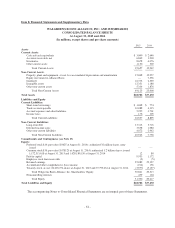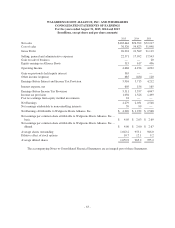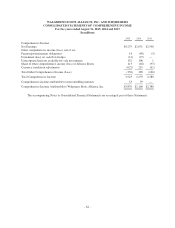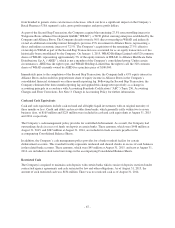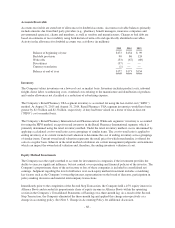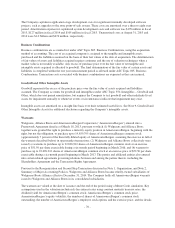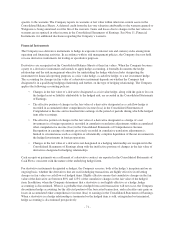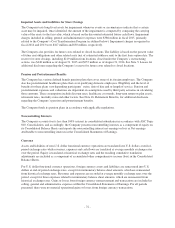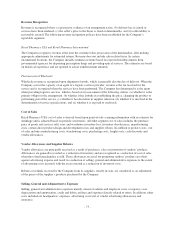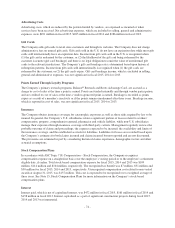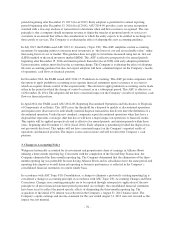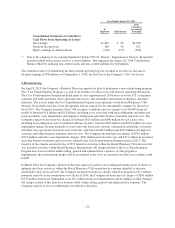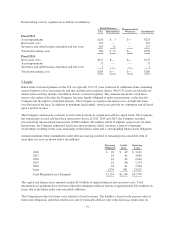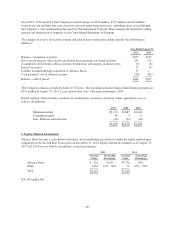Walgreens 2015 Annual Report Download - page 75
Download and view the complete annual report
Please find page 75 of the 2015 Walgreens annual report below. You can navigate through the pages in the report by either clicking on the pages listed below, or by using the keyword search tool below to find specific information within the annual report.specific to the warrants. The Company reports its warrants at fair value within other non-current assets in the
Consolidated Balance Sheets. A deferred credit from the day-one valuation attributable to the warrants granted to
Walgreens is being amortized over the life of the warrants. Gains and losses due to changes in the fair value on
warrants are recognized in other income in the Consolidated Statements of Earnings. See Note 11, Financial
Instruments, for additional disclosure regarding the Company’s warrants.
Financial Instruments
The Company uses derivative instruments to hedge its exposure to interest rate and currency risks arising from
operating and financing activities. In accordance with its risk management policies, the Company does not hold
or issue derivative instruments for trading or speculative purposes.
Derivatives are recognized on the Consolidated Balance Sheets at their fair values. When the Company becomes
a party to a derivative instrument and intends to apply hedge accounting, it formally documents the hedge
relationship and the risk management objective for undertaking the hedge which includes designating the
instrument for financial reporting purposes as a fair value hedge, a cash flow hedge, or a net investment hedge.
The accounting for changes in fair value of a derivative instrument depends on whether the Company had
designated it in a qualifying hedging relationship and further, on the type of hedging relationship. The Company
applies the following accounting policies:
• Changes in the fair value of a derivative designated as a fair value hedge, along with the gain or loss on
the hedged asset or liability attributable to the hedged risk, are recorded in the Consolidated Statements
of Earnings.
• The effective portion of changes in the fair value of a derivative designated as a cash flow hedge is
recorded in accumulated other comprehensive income (loss) in the Consolidated Statements of
Comprehensive Income and reclassified into earnings in the period or periods during which the hedged
item affects earnings.
• The effective portion of changes in the fair value of a derivative designated as a hedge of a net
investment in a foreign operation is recorded in cumulative translation adjustments within accumulated
other comprehensive income (loss) in the Consolidated Statements of Comprehensive Income.
Recognition in earnings of amounts previously recorded in cumulative translation adjustments is
limited to circumstances such as complete or substantially complete liquidation of the net investment in
the hedged investments in foreign operations.
• Changes in the fair value of a derivative not designated in a hedging relationship are recognized in the
Consolidated Statements of Earnings along with the ineffective portions of changes in the fair value of
derivatives designated in hedging relationships.
Cash receipts or payments on a settlement of a derivative contract are reported in the Consolidated Statements of
Cash Flows consistent with the nature of the underlying hedged item.
For derivative instruments designated as hedges, the Company assesses, both at the hedge’s inception and on an
ongoing basis, whether the derivatives that are used in hedging transactions are highly effective in offsetting
changes in fair values or cash flows of hedged items. Highly effective means that cumulative changes in the fair
value of the derivative are between 80% and 125% of the cumulative changes in the fair value of the hedged
item. In addition, when the Company determines that a derivative is not highly effective as a hedge, hedge
accounting is discontinued. When it is probable that a hedged forecasted transaction will not occur, the Company
discontinues hedge accounting for the affected portion of the forecasted transaction, and reclassifies any gains or
losses in accumulated other comprehensive income (loss) to earnings in the Consolidated Statements of Earnings.
When a derivative in a hedge relationship is terminated or the hedged item is sold, extinguished or terminated,
hedge accounting is discontinued prospectively.
-71-


